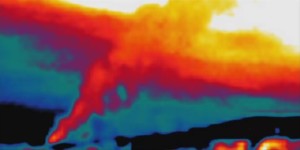Last week Governor Brown issued a proclamation that declares the Aliso Canyon methane leak an emergency.
The broken well at the Southern California Gas Company’s Aliso Canyon natural gas storage site has released more than 80,000 metric tons of the powerful climate pollutant methane since the rupture was first detected on October 23. This is the equivalent of more than one million car trips, or more than 800 million gallons of gasoline. $13 million of natural gas has been wasted. If this alone wasn’t scary enough, Aliso Canyon Leak may be just the tip of the iceberg. There are 13 other underground methane gas storage facilities in the state and most of the storage capacity is located in or near urban areas.
How does a disaster at this scale happen?
The well was drilled in 1953 for oil production and converted to a natural gas reservoir in 1973. While well construction practices have evolved significantly in that time, the well has not been updated. The recent leak is the result of removing and not replacing a safety valve in 1979. This is disheartening not because this resulted in malfeasance, but because it appears that the well was in compliance with state regulations.
Many people blame SoCal Gas for this problem, and they may be right. In terms of transparency, you should know that the Coalition for Clean Air has benefitted from charitable donations from SoCal Gas, and has supported their efforts to reduce air pollution by providing alternative fuels for heavy duty trucks, developing near-zero emission heavy duty truck engines, increasing the production and use of renewable natural gas, and other programs. While we’re not in a position to judge how much of the fault for the well failure rests with SoCal Gas, or whether their response to this tragedy has been appropriate, it does seem clear that better policies and regulations could have prevented what happened at Aliso Canyon and may prevent similar problems at other natural gas storage reservoirs.
Gas wells are regulated under the flawed Underground Injection Control program (created in 1983) run by the California Division of Oil, Gas, and Geothermal Resources’ (DOGGR). “Critical” wells — that is, those located within 100 feet of a road or a park, or within 300 feet of a home — require a safety valve. Because the well at Aliso Canyon was not identified this way, the safety valve was not required.
As disappointed as we might be with DOGGR, much of the problem lies with the lack of outside the silo regulatory coordination and planning. Seven state agencies are involved in the response. Yet, there isn’t a single statutory point of responsibility and accountability to oversee response and remediation actions. Despite being the nation’s climate change leader, we have done almost nothing to reduce emissions of short-term climate pollutants such as methane. The California Air Resources Board (ARB) is now developing regulations for reducing methane emissions by 2030, but it appears that leaks such as the one at Aliso Canyon will not be covered.
The Policy Response
Elected officials aren’t taking the leak lightly. A new set of laws have been proposed (SB 875, SB 876, SB 877, and SB 878) to deal with the existing leak and guard against future disasters. These new bills will create a moratorium on any new injections of natural gas in old wells, designate a single point of accountability in State government, require all GHG mitigation cost impacts of the gas leak to be paid for from utility profits, prohibit the California Public Utilities Commission from allocating any costs associated with cleanups to gas ratepayers, strengthen natural gas storage facility and well standards, and implement a strategy to reduce emissions of Short Lived Climate Pollutants, such as methane from gas storage facilities. Locally, the South Coast Air Quality Management District Governing Board adopted a penalties and mitigation resolution seeking to put have mitigation funds invested back into communities impacted by the environmental damages caused by the Aliso Canyon leaks.
Lessons From Aliso Canyon
If the failure of DOGGR to regulate the well at Aliso Canyon tells us anything, it’s that we need to pay attention not only to policy creation, but to the nuances of policy implementation, enforcement and interpretation. After all, by all appearances the well was technically in compliance, but as we know now, that should not have been the case. Had the agency interpreted their rules differently, things could have been much different.
The Coalition for Clean Air and our allies work at the capital, in the halls of justice, and within the state regulatory agency bureaucracy to make sure your voice is heard. Our work in the latter that gets the least attention, yet can have some of the biggest impacts in the lives of everyday people. The failure of these agencies to prevent a leak of this magnitude is a reminder to us to double down on our efforts to advocate for policies that do the right thing.
Specifically, ARB needs to account for so-called “fugitive” GHG emissions such as these when setting climate goals and policies. We also need to reduce our dependency upon non-renewable natural gas to generate the electricity and hydrogen that powers zero emission vehicles. A very important lesson to recognize is the importance of diversifying, as well as expanding, California’s renewable energy portfolio and to support the development of renewable natural gas resources. For this we will need to push technological innovations for sustainable energy and zero emission transportation while increasing the availability of our energy storage capacity, since solar and wind renewable energy are not always being generated when we need them.
The attention on America’s aging and accident-prone oil and gas infrastructure provides a great opportunity for the Coalition for Clean Air to advocate for new, better and more protective policies. We’ll be there for you to do just that.
Photo Source: Environmental Defense Fund
[share title=”Share This Post”]








